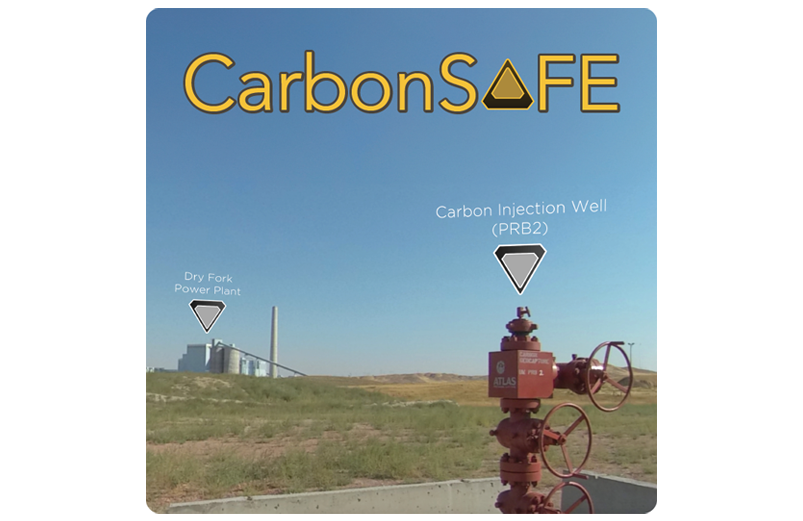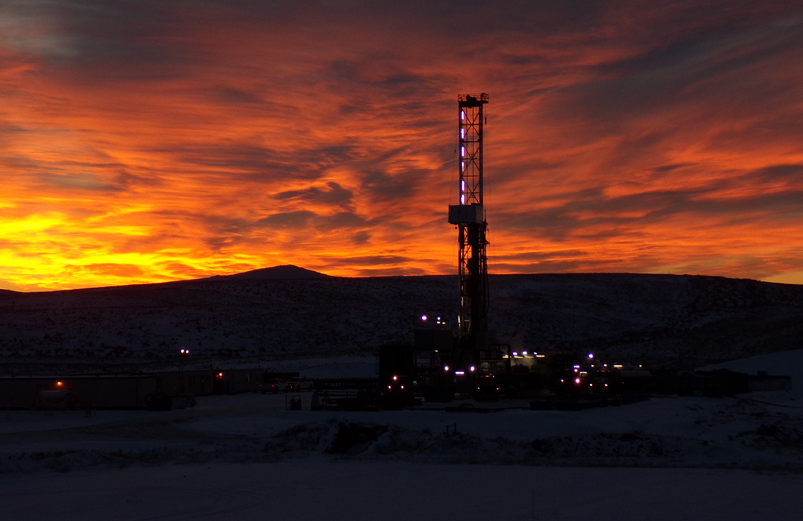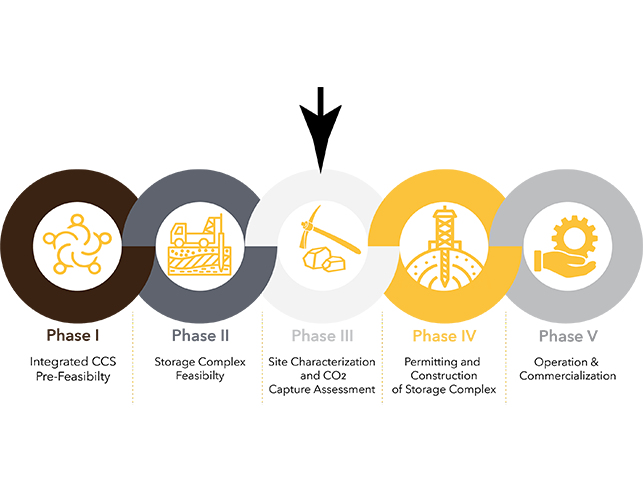Project Phases
Wyoming CarbonSAFE Phase I: Integrated Carbon Capture and Storage Pre-Feasibility
Phase I consisted of a pre-feasibility plan and team assembly. Initial formations investigated included the Muddy, Lakota, Fall River (Dakota Group), Lower Sundance, and Minnelusa Formations, which are overlain by thousands of feet of impermeable rock that would ensure the permanent containment of carbon dioxide fluids in the storage sites.
Wyoming CarbonSAFE Phase II: Commercial Storage Complex Feasibility
Phase II of the project commenced to assess the storage complex feasibility, with major activities including drilling a test well at the site and conducting a 3-D geophysical survey. The test well was completed at a total depth of 9873 feet and 625 feet of core samples from nine different geological formations were collected for analysis.
Wyoming CarbonSAFE Phase III: Site Characterization and CO2 Capture Assessment
Phase III project objectives are to finalize site characterization, complete Class VI permitting to construct, integrate Membrane Technology and Research, Inc.’s (MTR) CO2 capture assessment, and conduct National Environmental Policy Act analyses to advance towards commercialization of a large-scale CCUS project at Dry Fork Station.
CarbonSAFE 360 App
Experience a first-person view of the sheer scale of our CarbonSAFE Project. Developed by the 3D Visualization Center, this interactive tool shows the audience how deep CO2 would be injected and stored into the subsurface. Learn about the different geological formations as you reach two miles under the earth’s surface to see the CO2 storage zones and caprock seals.
How To Use The App:
Look Around - click and hold the left mouse button then drag your mouse around to pan the view.
Interact - Left click on any yellow triangle icons to trigger something to happen.

Other CarbonSAFE Projects
The University of Wyoming's School of Energy Resources (SER) has established itself as a leader in Carbon Capture Utilization and Storage (CCUS) research, particularly excelling in the critical area of applied geotechnical research and subsurface characterization. Their expertise encompasses advanced modeling techniques to simulate CO2 injection and storage behavior within various geological formations.
Rock Springs Uplift
The Center for Economic Geology Research (CEGR) was awared a one year prefeasibility study surrounding the Rock Springs Uplift in southwestern Wyoming as part of the DOE’s Carbon Storage Assurance and Facility Enterprise (CarbonSAFE) program. The ultimate goal of the CarbonSAFE program is to safely store 50+ million metric tons of CO2 into a saline geologic storage complex. The Rock Springs Uplift Project did not not advance to subsequent phase, but much was learned on the project and many discoveries were made possible by this research.
HERO Basalt CarbonSAFE
The HERO Basalt CarbonSAFE plans to accelerate the scale-up and deployment of commercial CO2 storage in basaltic rocks at a storage complex near Hermiston, Oregon. The two-year feasibility study will include drilling a test well for the collection of data from these formations; obtaining and analyzing geologic samples; using the results of the analyses to create geologic computer models in which to test storage scenarios; and assessing societal and environmental impacts of the carbon storage at the site.
Williams Echo Springs CarbonSAFE
Williams Echo Springs CarbonSAFE project aims to conduct a storage complex feasibility study to develop a saline carbon dioxide storage hub for current and future industries in the Echo Springs area of south-central Wyoming. The two-year study plans to be conducted in collaboration with midstream natural gas company Williams to permit and drill a deep stratigraphic test well and interpret the resulting data, models and documents for further site development.
Sweetwater Carbon Storage Hub
The project, which is led by researchers in SER’s Center for Economic Geology Research, along with Frontier Carbon Solutions, the owner and operator of the Sweetwater Carbon Storage Hub, will develop a permanent carbon management solution for the region’s critical hydrocarbon industries. The project will focus on the detailed site characterization, planning and permitting stages of project development under Phase III of the CarbonSAFE program.
Have a question about CCUS? Ask Us!
Do you have any questions about Carbon Capture, Utilization and Storage in Wyoming? Please submit your question here and research scientists in the Center for Economic Geology Research will address your question in the frequently asked questions, or will reach out to you directly with an answer.



